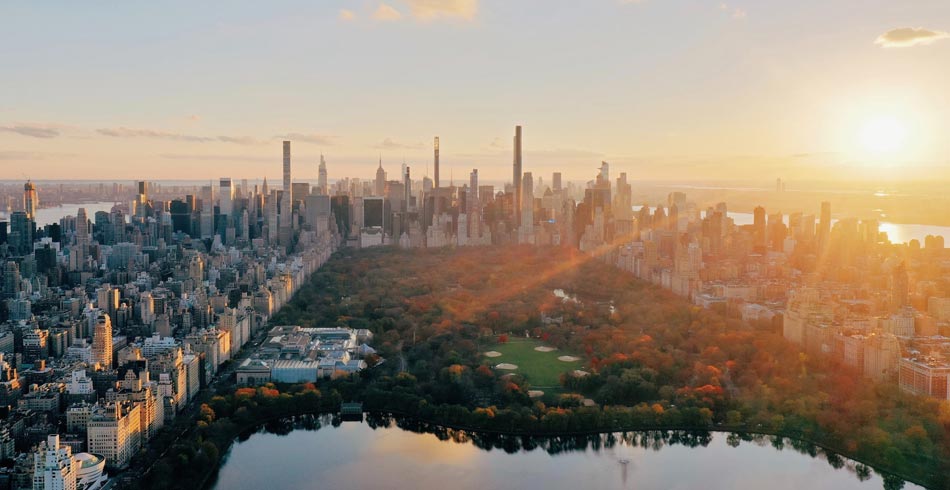Central Park is the world’s greatest urban space located right in the center of Manhattan in the bustling city of New York in the US. It is a stretch of lush green landscape that provides a happy respite from the strife of city life.
The park spreads across 2.5 miles (approximately 843 acres) along a carpet of green grassy lawns and encompasses serene lakes and ponds, historical landmarks, landscaped woodlands, and more.
With the rapid growth in industrialization and urbanization in the 19th century, forest areas and open grasslands began to shrink dramatically which eventually threatened the ecosystem. Cities grew at the cost of usurping and compromising green space. There was large-scale migration of workers from remote areas into New York City. This soon resulted in unclean air, fetid water, mountains of human refuge, and extreme density.
The idea of having a sylvan retreat within the city limits became an appealing idea to the founding fathers of Central Park. They waged a campaign for a greener, cleaner New York in the 19th century. They envisaged a plan that would enrich the lives of ordinary New Yorkers. The finest among them came up with a master plan for a people’s park that would be open to all. The project was overseen by landscape architects Frederick Olmsted and Calvert Vaux.
The original plan was devised with an easy entryway, water-filled ponds, the installation of 36 bridges throughout the park, a sheep’s meadow, and statues of 19th-century icons. The park decayed with the passage of time but was also restored from time to time to preserve and maintain this stunning piece of natural infrastructure. A zoo was the most fascinating addition to the park in the mid-19th century. New pathways and a jogging track made the park a hit with New Yorkers.
Ever since it was completed in 1873, the park has remained a beloved destination for New Yorkers as it offers them an idyllic place to relax, enjoy, and admire nature in its bounty.
Central Park attracts millions of visitors from around the world each year. It is an important cultural landmark of the city.
Did You Know These 5 Facts About Central Park

- Largest Public Park in New York: Central Park spreads over 843 acres of land in the heart of Manhattan in New York City, making it the largest public park in the city. Moreover, it was also the first landscaped park to come up in the whole of the United States in the 19th century. You will be surprised to know that Central Park is even larger than some countries like Monaco and Vatican City.
- Encompasses Many Features: There are multiple attractions inside the park. These include outdoor theaters, zoos, historical exhibits, amusement areas, boating facilities, concert shells, fountains and water bodies, a skating rink, designated areas for walking/jogging/cycling, etc. It is no wonder then that Hollywood filmmakers prefer the premises to film their movies because of its versatility and extensiveness. The park features in no less than 350 films.
- Vital Source of Green Space: Over 25,000 trees and shrubs were planted in the park during its construction. This was a welcome respite for many 19th-century city dwellers because the air quality was rapidly deteriorating because of rapid industrialization. Today, the park is home to over 170,000 trees, making the park a vital source of green space.
- Home to Several Species of Wildlife: The park is home to several species of wildlife like squirrels, birds, raccoons, and even larger ones like coyotes and deer that encroach upon the premises from the surrounding areas.
- Most Visited Park in The US: The park receives heavy footfall annually, with approximately 42 million visitors every year. It is the most visited urban park not only in New York but the whole of the US. Visitor volume sometimes exceeds the population of many cities around the world which is a testament to the park’s enduring popularity and cultural significance.
Know the 5 Myths Surrounding Central Park

- Central Park Was Designed by a Single Person: The park was never conceived and designed by a single person. It was the collaborative effort and vision of Frederick Law Olmsted and Calvert Vaux, both of whom were American landscape architects of the 19th century.
- Central Park Was Always Safe: In the 1970s and 80s, the park became a den of crime for muggers and rapists. It was considered a dangerous place, unfit to visit for recreational purposes. However, that was then. Today, thanks to the efforts of some philanthropists and the local government, the safety factor of the park has considerably improved, and is relatively a safe destination to visit with family and friends.
- Central Park is All Natural: While Central Park features a pastoral landscape that is designed to look natural, it is actually a carefully managed urban park. Much of the park’s infrastructure is artificially constructed and modified to lend a natural look and feel.
- Central Park is For Tourists Only: The park welcomes both locals and tourists and is not restricted to tourists alone. Many New Yorkers use the sprawling space for activities like recreation and picnicking, and for playing sports and performing exercises like walking, jogging, running, and cycling.
- Central Park Was Built to Erase the Black and Hispanic Communities: This is a completely false assumption and baseless too. Though the construction of the park indeed involved removing some existing settlements, the primary objective was to design a lush green space in a rapidly growing and industrializing city. The conception and construction of the park had nothing to do with wiping out a specific community from the area. At the time of construction, the area around Central Park was already sparsely populated and undeveloped. It was hardly inhabited by people. The agenda was to create an inclusive public place that would be open to all.

